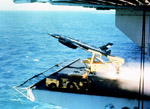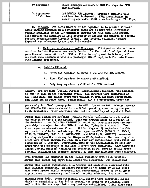

Teledyne-Ryan supplied ten Model 147SK low-altitude photo recce Firebees to the US Navy. The Model 147SK had no AQM-34 designation, but it was comparable to the USAF's Model 147SC / AQM-34L, modified for ground launch. In fact it was the first Model 147 that was ground-launched. Attachment points for the RATO bottle's brace were added under the horizontal stabilisers (also seen on the AQM-34V).
According to Robert Chisman (Teledyne-Ryan aerodynamicist and project engineer), the SK was the first model to be flown without a ventral fin fitted to the parachute cone. It would interfere with the RATO bottle, and they were expensive to produce and lost with each recovery. To restore directional stability, end plates were fitted. These endplates were later also fitted to 147S series models, because the deletion of the ventral fin on these versions resulted in directional stability problems and several losses during operational missions.
NAS Point Mugu
three test launches in July 1969. The first flight had a pitch-up problem and crashed close to the launch site
USS Bennington, CVS-20
two test launches in August 1969, off the coast of California, from the aft starboard elevator. The second launch went wrong: the JATO ignited when the jet engine was supposed to be started. The Bennington was suddenly decommissioned, ending these trails.
USS Ranger, CVA-61
Three 147SKs and a Teledyne-Ryan crew were loaded in Alameda
While sailing from Alameda to Pearl Harbour in October, one flight was performed, with a wet recovery.
While sailing from Pearl Harbour to Subic Bay, one flight was performed, again with a wet recovery
On station in the Gulf of Tonkin, the system was declared operational. Code name 'Belfry Express' was assigned for the operational photo missions
During short stops at Subic Bay, more 147SKs were loaded on-board. One more was transfered by Underway Replenishment
Missions:
Belfry-1: 23 November 1969, over North Vietnam'a Highway 1 along the coast. Wet recovery. Launched across catapult 1.
Belfry-2: 27 November 1969, with SK-5, wet recovery. Good photo results.
Belfry-3: 30 November 1969, with SK-3, MARS recovery by USAF
Belfry-6: 21 December 1969, with SK-3, MARS recovery by USAF. Excellent photo results.
No record of missions seven, eight and nine
Belfry-10: 2 January 1970, with SK-5. Excellent mission
Belfry-16: 10 January 1970, with SK-5. Launches had moved from across catapult 1 to 'point', to elevator 1 at flight deck level, and now to elevator 1 at hangar deck level. This made checking the beacon impossible, and the beacon was not acquired by the E-2 Hawkeye after launch. RPV was lost, but found on Hainan Island, China.
Belfry-24: 18 April 1970, with SK-8
operational mission on 22 April 1970
operational mission on 24 April 1970, chutes did not deploy
Belfry-27: 27 April 1970, MARS recovery
Belfry-31: last operational mission on 27 April 1970, with SK-10, main chute did not deploy
Craig Kaston kindly contributed these US Navy photos. The first photo shows a launch across the No. 1 catapult of the USS Ranger. According to 'Lightning Bugs', only the early launches were made like this, across catapult number 1.
The second photo shows the same launch I believe, but photographed from the fire truck on the front deck, visible in the first photo. This photo clearly shows that the vertical tail and the endplates were painted in the darkest of three grays. Lastly, the RATO bottle can be seen clearly in this photo.

|

|
Craig Kaston kindly also contributed this US Navy photo. This recovery photo clearly shows the camouflage of this Model 147SK. It was apparently adapted to the then-current Navy camouflage style of Gull Gray on the upper surface and White on the lower surface. However, there are two grays on the upper surface, with a scalloped edge. The same pattern is seen in other (black and white) photos of SK's too, so it strongly appears to have been the standard camouflage. This particular SK has a lighter color gray on the vertical tail and horizontal tail endplates, compared to the SK seen in the launch photos.

|
This photo comes from the San Diego Air and Space Museum photo archives on Flickr, via Craig Kaston. Judging from the JATO launch from elevator 1 at hangar deck level, this must be mission 'Belfry-16' on 10 January 1970, with SK-5. It was lost by the mission crew, but found by the Chinese on Hainan Island (see third photo). It's unclear why SK-5 was black overall, instead of the three-grays scheme seen on other Model 147SKs. But it makes visual identification of the Hainan bird easy. It has three white areas: the small hatch on the nose cone, a rectangular area below the camera hatch, and a white area above the rudder.

|

|

|
The squadron's 1969 operations report contains several references to 'Belfry Express' operations. Of note is the use of 'Special Purpose Reconnaissance Aircraft' (SPRA), whereas 'Special Purpose Aircraft' (SPA) was common in the Air Force. All references to the 147SK were gathered in one picture.

|
Similarly, the 1970 operations report contains a few references to 'Belfry Express' operations.

|